Display Aircraft for 2017
(Additional display aircraft will be added as confirmed)

Display Aircraft for 2017 (Additional display aircraft will be added as confirmed) |
 |
|
|||
    The Fairchild Republic A-10 Thunderbolt II is a twin-engine jet aircraft developed by Fairchild-Republic in the early 1970s. It is the only United States Air Force production aircraft designed solely for close air support, including attacking tanks, armored vehicles, and other ground targets. The A-10 was designed around the 30 mm GAU-8 Avenger rotary cannon that is its primary armament and the heaviest-ever automatic cannon mounted on an aircraft. The A-10's airframe was designed for durability, with measures such as titanium armor to protect the cockpit and aircraft systems, enabling it to absorb a significant amount of damage and continue flying. The A-10's official name comes from the Republic P-47 Thunderbolt of World War II, but is more commonly known by its nickname "Warthog" or "Hog". Its secondary mission is to provide airborne forward air control, directing other aircraft in attacks on ground targets. Two A-10 aircraft come to us from the 442nd Fighter Wing, Whiteman Air Force Base. Max takeoff weight: 50,000 lb. Max speed: 439 mph.
|
|||
|
|||
 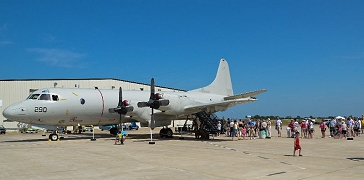  The Lockheed P-3 Orion is a four-engine turboprop anti-submarine and maritime surveillance aircraft developed for the United States Navy and introduced in the 1960s. Lockheed based it on the L-188 Electra commercial airliner. The aircraft is easily distinguished from the Electra by its distinctive tail stinger or "MAD Boom", used for the magnetic detection of submarines. Over the years, the aircraft has seen numerous design advancements, most notably to its electronics packages. The P-3 Orion is still in use by numerous navies and air forces around the world, primarily for maritime patrol, reconnaissance, anti-surface warfare and anti-submarine warfare. A total of 734 P-3s have been built, and in 2012, it joined the handful of military aircraft that have served 50 years of continuous use by the United States military. This one comes to us from the “Pro’s Nest” Patrol Squadron VP-30, NAS Jacksonville, FL. Max takeoff weight: 142,000 lbs. Max speed: 473 mph. Open for tours.
|
|||
|
|||
  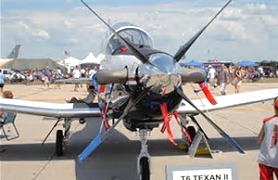  The Beechcraft T-6 Texan II is a single-engine turboprop aircraft built by the Raytheon Aircraft Company. A trainer aircraft based on the Pilatus PC-9, the T-6 has replaced the Air Force's Cessna T-37B Tweet and the Navy's T-34C Turbo Mentor. The T-6A is used by the United States Air Force for basic pilot training and Combat Systems Officer training and by the United States Navy and United States Marine Corps for Primary and Intermediate Naval Flight Officer training. The T-6B is also the primary trainer for U.S. Student Naval Aviators. This T-6 II comes to us from Laughlin Airforce Base 47th Flying Training Wing, Del Rio, Texas. Max weight: 24,500 lb. Max speed: 345 mph.
|
|||
|
|||
    The Grumman C-2 Greyhound is a twin-engine, high-wing cargo aircraft, designed to carry supplies, mail, and passengers to and from aircraft carriers of the United States Navy. Its primary mission is carrier onboard delivery (COD). The aircraft provides critical logistics support to carrier strike groups. The aircraft is mainly used to transport high-priority cargo, mail and passengers between carriers and shore bases, and can also deliver cargo like jet engines and special stores. This C-2 comes to us from the VRC-30 'Providers', NAS North Island, San Diego CA. Max weight: 60,000 lb. Max speed: 394 mph.
|
|||
|
|||
    The Sikorsky MH-60s Seahawk helicopter is the world’s most advanced maritime helicopter. Operational and deployed today with the U.S. Navy as the primary anti-submarine warfare anti-surface weapon system for open ocean and littoral zones, It is the most capable naval helicopter available today designed to operate from frigates, destroyers, cruisers and aircraft carriers. This Seahawk is brought to us from "Fleet Angels" Helicopter Sea Combat Squadron TWO, Norfolk VA Max weight: 21,884 lb. Max speed: 168 mph.
|
|||
|
|||
     "Miss Belle" is a rare example of a 1958 flying C1-A "Trader" that took 10 years of dedicated restoration efforts. She had a 30 year career in the US Navy traveling the globe, amassing nearly 16,000 Flying Hours with over 800 arrested landings and 190 carrier catapult launches. C1-A Traders were used throughout the 1960s and 1970s carrying mail and supplies to aircraft carriers on station in the Pacific Ocean during the Vietnam War, and also served as a trainer for all-weather carrier operations. Acquired in 1999 by Doug Goss (Chief Pilot) and Richard Cronn, this C1-A brings back memories for Vietnam era Navy Veterans and shows the magic of her enormous folding wings. "Miss Belle" comes to us from Trader Air, Inc. located in Topeka KS. Max weight: 24,500 lb. Max speed: 345 mph.
|
|||
|
|||
    This airplane is one of only four known Seafire Mk. XVs to exist in the world and it may be the only flying Supermarine Seafire Mk. XV in the world. Dr. Wes Stricker's immaculate Supermarine Seafire Mk. XV (also known as the "hooked Spitfire") is based in Columbia, MO, was restored by Jim Cooper, and made its first post-restoration flight in 2010. The Supermarine Seafire was a naval version of the Supermarine Spitfire specially adapted for operation from aircraft carriers. The Seafire's mission was primarily as a short range interceptor. Wing span: 36ft 10in. Max takeoff weight: 7,640 lb. Max speed: 359 mph. Power: 1,850 hp.
|
|||
|
|||
    Originally designated the X-70, the Stearman PT-17 was designed in 1933 to meet the US Air Corps requirements for a new trainer. Over 10,000 Kaydet's of different variants were ultimately built. This particular Kaydet was built in 1942 and used as a trainer in the Royal Canadian Air Force until 1944, at which time it was returned to the US Army Air Corps. It was mustered out in 1945, after which it spent the next 20+ years towing advertising banners over Cape May, NJ. Rod Hightower obtained this PT-17 as a "basket case" and in 1990 began a 7-year restoration. Max takeoff weight: 2,635 lb. Maximum speed: 135 mph.
|
|||
|
|||
 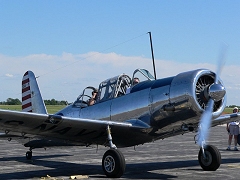   The Vultee BT-13 Valiant was an American World War II-era basic trainer aircraft built by Vultee Aircraft for the United States Army Air Corps, and later US Army Air Forces. The Vultee BT-13 was the basic trainer flown by most American pilots during World War II. It was the second phase of the three phase training program for pilots. After primary training in PT-13, PT-17, or PT-19 trainers, the student pilot moved to the more complex Vultee for continued flight training. The BT-13 had a more powerful engine and was faster and heavier than the primary trainer. It required the student pilot to use two way radio communications with the ground and to operate landing flaps and a two-position Hamilton Standard controllable-pitch propeller. It did not, however, have retractable landing gear or a hydraulic system. The flaps were operated by a crank-and-cable system. Its pilots nicknamed it the "Vultee Vibrator." This BT-13 is owned and flown by Jay Williams from Marceline MO. Wingspan: 42 ft. Max weight: 4,496 lb. Max speed: 180 mph. Power: 450 hp.
|
|||
|
|||
    "Kansas City Kitty" is a beautiful example of a 1945 North American P-51D Mustang long-range fighter and escort. Initially P-51's were built with an Allison engine and the fighter handled well at low altitudes but exhibited lackluster performance over 15,000 feet. Rolls-Royce was invited to review the aircraft, and the result was legendary: with the Rolls-Royce 61 engine, the fighter could reach 433 mph at 20,000 feet, with an absolute ceiling of 40,300 feet. This combination catapulted the Mustang to near-mythic status, which continues today. Kansas City Kitty is owned and flown by Dr. Wes Stricker based in Columbia, MO. Loaded weight: 9,200 lb. Max speed: 437 mph.
|
|||
|
|||
    "Archie" is another beautiful example of a North American P-51 Mustang fighter, owned by "Captain" Lee Maples, Vichy, MO. At the start of Korean War, the Mustang was the main fighter of the United Nations until jet fighters such as the F-86 took over this role; the Mustang then became a specialized fighter-bomber. Despite the advent of jet fighters, the Mustang remained in service with some air forces until the early 1980s. After World War II and the Korean War, many Mustangs were converted for civilian use, especially air racing.. Loaded weight: 9,200 lb. Max speed: 437 mph.
|
|||
|
|||
   The North American Aviation T-6 Texan was a single-engine advanced trainer aircraft used to train pilots of the United States Army Air Forces , United States Navy , Royal Air Force and other air forces of the British Commonwealth during World War II and into the 1950s. Designed by North American Aviation , the T-6 is known by a variety of designations depending on the model and operating air force. The USAAC and USAAF designated it as the AT-6, the United States Navy the SNJ, and British Commonwealth air forces, the Harvard, the name it is best known by outside of the US. After 1962, US forces designated it the T-6. It remains a popular warbird aircraft used for airshow demonstrations and static displays. This T-6 is owned and flown by Dr. Wes Stricker based in Columbia, MO. Wingspan: 42 ft. Loaded weight: 5,617lb. Power: 600 hp. Maximum speed: 208 mph.
|
|||
|
|||
    The SIAI-Marchetti SM.1019 was an Italian STOL (Short TakeOff and Landing) liaison monoplane built by SIAI-Marchetti for the Italian Army and based on the O-1 Bird Dog. To meet an Italian Army requirement for a short take-off liaison aircraft, SIAI-Marchetti modified the design of the Cessna 305A/O-1 Bird Dog with a new turboprop engine and a revised tail unit. The prototype first flew on 24 May 1969 powered by a 317hp (236kW) Allison 250-B15C turboprop engine. It was evaluated against the Aermacchi AM.3 and was successful and won a production order for 80 aircraft. This SIAI-Marchetti SM.1019 is owned and flown by Dr. Wes Stricker based in Columbia, MO. Wingspan: 36 ft. Gross Weight: 3,196 lbs. Power: 400 hp (turboprop). Maximum Speed: 177 mph.
|
|||
|
|||
    Piper L4 (O-59) "Grasshopper" Observation/Liaison aircraft (military version of the J3 Cub). The L4 was manufactured by Piper Aircraft for the U.S. Army Air Force for liaison and artillery spotter/director duties. It became one of the most popular of the light "Grasshopper" class of liaison aircraft and was also was heavily used for the initial phase of pilot training. This specific aircraft was built in 1945 as an L-4J in olive drab colors and delivered to the Army Air Corps. It was transferred from the military to a civilian registration in 1956, however it still displays it's military heritage in olive drab paint and D-Day invasion stripes. This aircraft is owned and flown by Mark Pierce of the Kansas City Dawn Patrol. Wingspan: 35' 3". Empty weight: 765 lbs. Max. takeoff weight: 1,220 lbs. Cruise speed: 75mph. Horsepower: 65 hp.
|
|||
|
|||
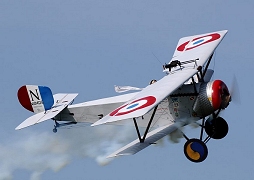    Introduced in 1916, the Nieuport 11 was an extremely successful French-built WW I fighter. It was flown by the French, British, and Russian armed forces. Dicks' is painted in the colors of the 1916 Lafayette Escadrille, the first planes ever flown by American pilots in an organized squadron in WWI. The screaming Sioux Indian head painted on the side of the fuselage adopted by the pilots of the Lafayette Escadrille was the logo from a box of Savage Arms .303 machine gun ammunition. The Lewis 303 drum-fed machine gun mounted on the top wing was there to shoot over the propeller’s arc because at that time, the allies did not have the technology to fire the machine gun through the propeller without hitting the spinning prop. This replica was plans built by aviation author Dick Starks in in conjunction Tom Glaeser's Nieuport in 1984. It is 7/8 scale and powered with a Volkswagon engine and based in Kansas City.
|
|||
|
|||
    This Morane-Saulnier "L" is a scale replica of the first airplane to shoot down a Zeppelin in WW I. The Morane-Saulnier was one of the first successful fighter planes. It was built in both one- and two-seat configurations. It had a forward-facing machine gun that fired through the arc of the propeller, which was armored so as to deflect any shots that struck it. Overall, about 600 were built. Its success triggered a rapid aircraft cycle in several nations, which quickly rendered it obsolete. Interestingly, the first fighter-fighter victory occurred when a German Fokker shot down one of the two-seat versions of the L-series aircraft. This is an Airdrome Airplanes replica and was built and flown by Sharon Starks of Parkville, MO. This specific aircraft appeared in the movie Amelia. A story about Amelia Earhart.
|
|||
|
|||
 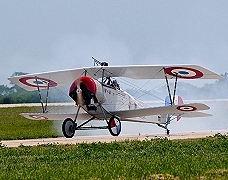    The Nieuport 16 was an improved version of the Nieuport 11 with a more powerful engine and the addition of a small headrest behind the cockpit. It was flown by the French, British, and Russian armed forces. This one is painted in the colors of the 1916 Lafayette Escadrille, the first planes ever flown by American pilots in an organized squadron in WWI. The Lewis 303 drum-fed machine gun mounted on the top wing was there to shoot over the propeller’s arc because at that time, the allies did not have the technology to fire the machine gun through the propeller without hitting the spinning prop. This Nieuport 16 replica was plans built by Mark Pierce 1986. Based in Kansas City. It is 7/8 scale and powered with a Volkswagon engine.
|
|||
|
|||
  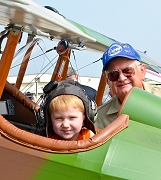  The Société Provisoire des Aéroplanes Deperdussin (SPAD) designed this aircraft as a WW I fighter. Appearing in 1916, it was first thought to be too heavy and unmaneuverable to be an effective fighter, but as pilots learned its strengths, it became one of the most capable fighters of the war, and one of the most-produced, with 8,472 built and orders for around 10,000 more cancelled at the Armistice. This beautiful replica was built and is flown by Marvin Berk from the Gardner Municipal Airport, home of the annual Gathering of Eagles.
|
|||
|
|||
    The Siemens-Schuckert D1 was a German single-seat fighter built by Siemens-Schukert Werke. A number of captured Nieuport 17 fighters were given to German aircraft manufacturers to study, the Siemens-Schukert Werke produced the D1 based on the captured fighter. The D1 was a biplane powered by 110 hp (82 kW) Siemens-Halske Sh1 rotary engine. An order for 150 aircraft for the Imperial German Army Air Service was placed, but these were delayed by late delivery of the complicated geared engine, so that the aircraft was outclassed in combat by newer Allied aircraft when delivered. Only 95 aircraft were produced, most of which were used for training. This 7/8s scale replica is powered by a Volkswagon engine and was built and flown by Marvin Story from the Gardner Municipal Airport, home of the annual Gathering of Eagles. |
|||
| Nieuport
28 project (full-scale replica project) |
|||
 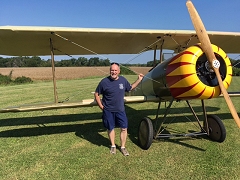   The Nieuport 28 was a French biplane fighter aircraft flown during World War I. Its principal claim to fame is that it was the first aircraft to see service with an American fighter squadron. It was designed to carry an up-to-date armament of twin synchronized machine guns, had a more powerful engine, and a new wing structure – for the first time a Nieuport biplane was fitted with conventional two spar wings, top and bottom, in place of the sesquiplane "v-strut" layout of earlier Nieuport types. The tail unit’s design closely followed that of the Nieuport 27, but the fuselage was much slimmer, in fact it was so narrow that the machine guns had to be offset to the left. The framework on display shows the modern aluminum construction used in the replicas. The plane was built by Ken Hines, also known as the "Voice of the Airshow".
|
|||
|
|||
  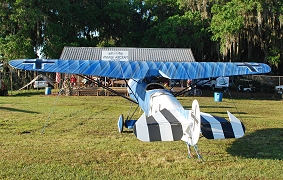  This is a replica of a the Fokker D.VIII German parasol-monoplane fighter aircraft built by Fokker-Flugzeugwerke in 1918. It was the last Fokker design to become operational with the Luftstreitkräfte, entering service in the last months of World War I. Dubbed the "Flying Razor" by Allied pilots, the D.VIII had the distinction of scoring the last aerial victory of the war. This replica was designed and built by Robert Baslee of Airdrome Aeroplanes located in Holden, MO. |
|||
|
|||
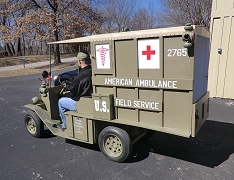     Early in WWI, horse-drawn carriages were used to transport the wounded but were quickly replaced by motor driven carriages. Some French and many American Ambulance Field Service (AAFS) ambulances were based on converted Ford Model T automobile chassis. American sponsored Ford Model Ts were sent over as a chassis and the passenger box was a kit strapped to the top for assembly in France. The Tin Lizzie quickly became a favorite of the drivers. Many of the same schools and towns that provided ambulance units also raised funds to provide an ambulance for their unit. The University of Missouri proudly put forth one of these units. All financed their own uniforms and transportation to France. The volunteer drivers of the AAFS were considered non-combatants and therefore could remain American citizens but were limited to medical transport. This ¾ scale replica is based on a 1915 Tin Lizzie and is built on a golf cart chassis by Dawn Patrol Members John O’Conner and the late Dave Laur. This year it will be transported and displayed at Salute by Steve Kenemore and Elaine Wheeler.
|
|||
|
|||
   The Ferret armored car, also commonly called the Ferret Scout car, is a British armored fighting vehicle designed and built for reconnaissance purposes. The Ferret was produced between 1952 and 1971 by the UK company, Daimler. It was widely adopted by regiments in the British Army as well as Commonwealth countries throughout the period. This vehicle is owned by Dr. Wes Stricker and is based in Columbia, MO. Weight: 3.7 Tons Engine: Rolls Royce 130 hp Speed: 58 mph
|
|||